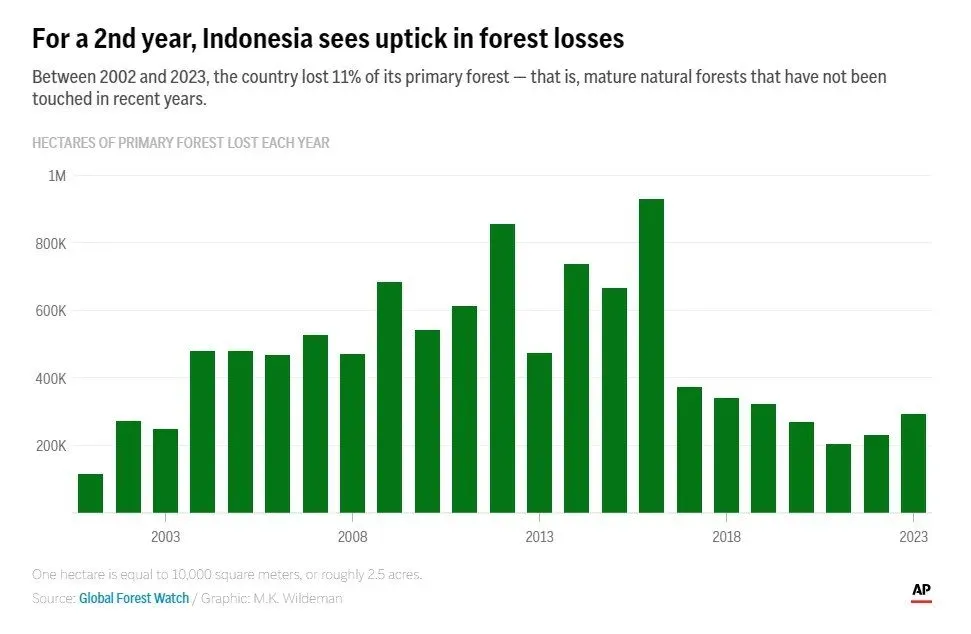Deforestation has increased sharply in Indonesia, scientists attribute this to mining for the transition to "green" energy
Kyiv • UNN
Deforestation in Indonesia increased by 27% in 2023 compared to the previous year. This is likely due to the extraction of nickel, which is necessary for the transition to green energy. Despite the decline in forests, scientists see a general upward trend in recent years.

The loss of primary forests in Indonesia increased by 27% in 2023 compared to the previous year. This is evidenced by data from the World Resources Institute, which analyzed the number of trees cut down in protected national parks and in massive jungles destroyed for palm oil and paper plantations. This was reported by the Associated Press, as reported by UNN.
Details
However, the World Resources Institute notes that these losses are still considered historically low compared to the massive deforestation in the 2010s.
Deforestation is down from six or so years ago, when it was at its peak. This is good and commendable news for Indonesia.
However, there are many other scientific organizations that are not as optimistic about this situation. They see this rise as a cause for concern. In particular, the recent deforestation is linked to the global appetite for mining Indonesia's vast nickel deposits, which is critical for the transition to green energy.
The latest data from the University of Maryland's Global Land Analysis and Detection Laboratory, published on Global Forest Watch, WRI's platform that provides data, technology, and tools for monitoring the world's forests, shows a negative trend in Indonesia's loss of primary forests - old-growth forests with high carbon content and rich biodiversity. The laboratory notes that their data exceeds official Indonesian statistics. They explain that much of Indonesia's primary forest loss, according to the analysis, is in areas that Indonesia classifies as secondary forests - areas that have regenerated mainly by natural processes after human activities such as crop cutting or timber harvesting. Secondary forests typically have a lower carbon storage capacity than primary forests.
Diverse forests more resilient to storms - study26.01.24, 02:00 • 31848 views
According to an analysis by Global Forest Watch, mining-related deforestation has occurred in Sumatra, Sulawesi, Mlauka, and Kalimantan.
The publication noted that Indonesia has the world's largest reserves of nickel, an important material for electric vehicles, solar panels, and other products needed for the transition to green energy. So scientists suggest that this deforestation may be directly related to the expansion of the Indonesian nickel industry. At least that's the opinion of Auriga Nusantara, a non-governmental environmental organization based in Indonesia. Manurung, the director of the organization, says it is not known exactly how much forest in Indonesia has been destroyed by mining. But he called it a “significant driver” and said that the government's rapid development of the country's mining and nickel industries - including more than 20 new plants to process nickel ore - “repeats Indonesia's mistakes in the oil palm and balance wood industries” in increasing deforestation.
According to Global Forest Watch, Indonesia is the largest producer of palm oil, one of the largest exporters of coal, and a leading producer of pulp for paper. It also exports oil and gas, rubber, tin, and other resources.
According to the analysis, the expansion of industrial plantations has occurred in several locations near existing palm oil and pulp and paper plantations on the tropical islands of Kalimantan and West Papua.

Indonesia's Ministry of Environment and Forestry said the expansion was part of concessions granted before the current administration took office in 2014.
The Associated Press sent a request to the Indonesian Ministry of Environment and Forestry to comment on the situation, but they did not respond to the journalists' request.
An earthquake struck off the coast of Indonesia28.04.24, 00:32 • 40137 views
For reference
Scientists note that the vast tropical archipelago stretching across the equator is home to the third largest rainforest in the world, with a variety of endangered wildlife and plants, including orangutans, elephants, and giant forest flowers. Some live nowhere else.
Since 1950, more than 74 million hectares (285,715 square miles) of Indonesian rainforest - an area twice the size of Germany - have been cut down, burned or degraded to develop palm oil, paper and rubber plantations, nickel and other raw materials.
In the 2010s, Indonesia experienced a large-scale expansion of oil palm, timber, and giant palm plantations. A study in the journal Nature Climate Change found that between 2004 and 2014, deforestation doubled to about 2 million hectares per year.
According to the analysis, in 2023, the loss of primary forests on plots of more than 100 hectares amounted to only 15% of the loss.
Rod Taylor, global director of WRI's forest program, attributes the lack of large-scale deforestation to the reputational risks companies face if they are found to be destroying trees. In recent decades, non-governmental organizations, consumers and governments, including the European Union, have been pushing companies to abandon deforestation practices.
In 2018, Indonesian President Joko Widodo suspended new permits for palm oil plantations for three years. According to government data, deforestation slowed in 2021-2022.
But small-scale primary forest loss was still common throughout the country, including in several protected areas such as Tesso Nilo National Park and Rawa Singkil Wildlife Sanctuary on the island of Sumatra. Both areas are home to endangered animals such as tigers and elephants.